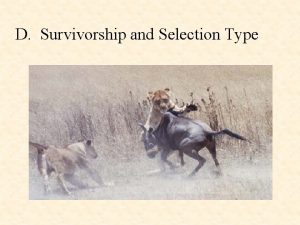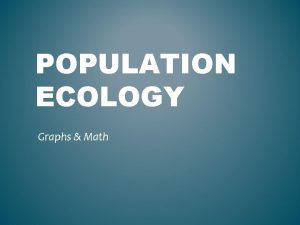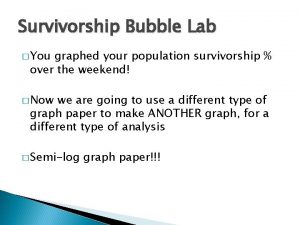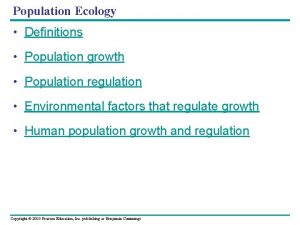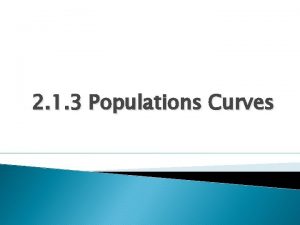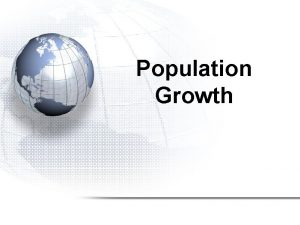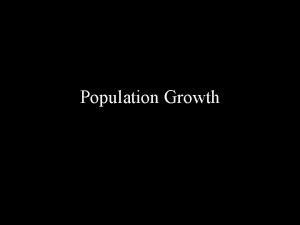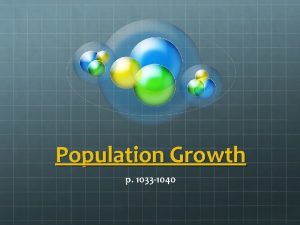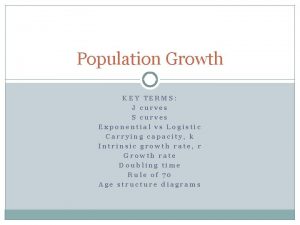ECOLOGY Population Growth Curves Survivorship curves Survival per















- Slides: 15

ECOLOGY Population Growth Curves

Survivorship curves Survival per thousand 1000 Human (type I) I. High death rate in post-reproductive years. – Humans – produce few offspring, but care for them Hydra (type II) 100 II. Constant mortality rate throughout life span. – some rodents & lizards, invertebrates Oyster (type III) 10 1 0 25 What do these graphs indicate regarding species survival rate & strategy? 50 75 Percent of maximum life span 100 III. Very high early mortality but the few survivors then live long (stay reproductive) – marine invertebrates, fish – produce large #s of offspring, but do not care for them

Number of survivors (log scale) Ideal Survivorship Curves I 1, 000 100 II 10 III 1 0 50 Percentage of maximum life span 100

Population Growth Curves d = delta or change N = population Size t = time B = birth rate D =death rate 4

Population Growth Models •

Exponential Growth Curves d = delta or change N = Population Size t = time rmax = maximum per capita growth rate of population Population Size, N Growth Rate of E. coli Time (hours) 6

Logistic Growth Curves 7

Logistic Growth Curves d = delta or change N = Population Size t = time K =carrying capacity rmax = maximum per capita growth rate of population 8

Comparison of Growth Curves 9

Growth Curve Relationship 10

Examining Logistic Population Growth Graph the data given as it relates to a logistic curve. Title, label and scale your graph properly. 11

Examining Logistic Population Growth Hypothetical Example of Logistic Growth Curve K = 1, 000 & rmax = 0. 05 per Individual per Year 12

Population Reproductive Strategies • r-selected (opportunistic) • Short maturation & lifespan • Many (small) offspring; usually 1 (early) reproduction • No parental care • High death rate • K-selected (equilibrial) • Long maturation & lifespan • Few (large) offspring; usually several (late) reproductions • Extensive parental care • Low death rate

How Well Do These Organisms Fit the Logistic Growth Model? Some populations overshoot K before settling down to a relatively stable density Some populations fluctuate greatly and make it difficult to define K 14

Age Structure Diagrams: Always Examine The Base Before Making Predictions About The Future Of The Population Rapid growth Afghanistan Male Female 10 8 6 4 2 0 2 4 6 Percent of population Age 85+ 80– 84 75– 79 70– 74 65– 69 60– 64 55– 59 50– 54 45– 49 40– 44 35– 39 30– 34 25– 29 20– 24 15– 19 10– 14 5– 9 0– 4 8 10 8 Slow growth United States Male Female 6 4 2 0 2 4 6 Percent of population Age 85+ 80– 84 75– 79 70– 74 65– 69 60– 64 55– 59 50– 54 45– 49 40– 44 35– 39 30– 34 25– 29 20– 24 15– 19 10– 14 5– 9 0– 4 8 8 No growth Italy Male Female 6 4 2 0 2 4 6 8 Percent of population
 Chapter 4 section 1 population dynamics answer key
Chapter 4 section 1 population dynamics answer key Section 1 population dynamics answer key
Section 1 population dynamics answer key Population ecology section 1 population dynamics
Population ecology section 1 population dynamics Study guide section 1 population dynamics
Study guide section 1 population dynamics Define exponential population growth
Define exponential population growth State of survival survival of the fittest tweak
State of survival survival of the fittest tweak State of survival survival of the fittest stages
State of survival survival of the fittest stages Apip adalah
Apip adalah Clumped dispersion
Clumped dispersion Fig 52
Fig 52 Ecosystem vs community
Ecosystem vs community Concept 3 population ecology
Concept 3 population ecology Chapter 53 population ecology
Chapter 53 population ecology Chapter 36 population ecology
Chapter 36 population ecology Chapter 4 population ecology answer key
Chapter 4 population ecology answer key Population ecology def
Population ecology def

















